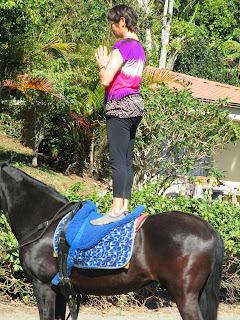The practice of Yoga and the Art of riding Classical Spanish Dressage
This is a good follow up to the previous blog that spoke of the 8 limbs of yoga and how they relate to riding.
Recently I began riding in a formal arena again after more than 10 years and after swearing I would never do another 20 meter circle ever again. In the past I had trained with some wonderful teachers here in Costa Rica. They were and are skilled riders and teachers. I purposefully left the life of arena riding and formal dressage lessons so many years ago because I felt something was missing from my riding. That something was a true and honest connection to my horse. This was not the fault of my teachers. I was not ready to understand and reach out for that connection at the time.
After many years of trail riding, mostly bareback and bridle less, I experienced that joyful and trusting connection true horse people have with their equine partners. I could not articulate that special relationship I developed with my horse but instinctively I knew this was what had been lacking in my previous arena training.
A true connection with your horse is simply an honest two-way conversation between you and your horse. It doesn't have to be mystical or magical, although sometimes it certainly feels like it is! It is the product of learning about general horse behavior and physiology. It is the natural result of becoming more aware and sensitive to one's own energy and how that is transmitted to and reacted to by your horse.
The practice of Yoga offers us daily opportunities to learn and experience lessons that we take to our horse training sessions. In yoga, as in dressage riding, mental preparation, soft mindful breath, mental conviction, and a gentle approach are the foundation to achieve union in Yoga and in Riding.
That is the attitude I bring to my yoga practice and now to my riding lessons. Every 20 meter circle, diagonal , or transition is an opportunity to forge and enhance my connection and communication with my horse. Knowing that my breath, mental resolve, and gentle manner are positively and constructively received by my horse has improved my riding.





